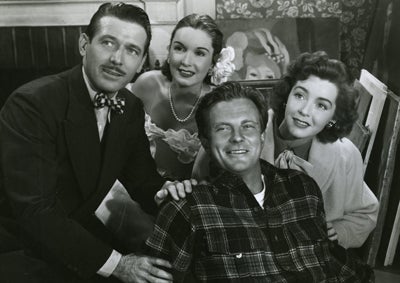Directed by Allan Dwan
The financial themes of The Inside Story must have resonated strongly with audiences of the time; 1948 was marked by monetary tightening and an economic downturn, anxious reminders of the economic uncertainty of the 1930s and the tenuous ongoing shift to a post-World War II peacetime economy. Indeed, the film’s opening titles suggest that the story about to unfold may have happened all across America, and that its teller, Uncle Ed, can be found in every small town.
Bookended by a present-day conversation in a bank deposit vault between Uncle Ed (played with folksy, genial charm by Charles Winninger in one of his last roles) and another bank customer who, to Uncle Ed’s disapproval, is hoarding a considerable sum of cash in his deposit box, the main action of The Inside Story, as related by Uncle Ed, takes place during the emergency bank holiday of 1933.
With banks closed and cash in short supply, the town of Silver Creek, Vermont is struggling, as residents are unable to pay their debts and keep their businesses running. A series of comedic misunderstandings ensue when innkeeper Horace Taylor (Gene Lockhart) mistakes $1,000 left in his safe for a payment from painter Waldo Williams (William Lundigan), indebted hotel guest and would-be fiancé of Horace’s daughter. Unfortunately, the money belongs to an out-of-towner anxious to get back to New York. Horace's increasingly desperate attempts to right his mistake demonstrate the importance of circulating money, as the cash passes through the hands of several townsfolk in turn, always one step ahead of the frantic Horace.
In a wry depiction of shifting Depression-era social and economic conditions, Horace’s money troubles are compounded by the presence of a pair of shifty bootleggers loafing in the hotel lobby, and he and other townspeople struggle to adjust to their daughters’ and wives’ new roles as family breadwinners. Money circulation has perhaps never been quite so entertaining an enterprise, and the value of a dollar so illuminated, as in this timely small-town comedy from Republic Pictures and the incredibly prolific Allan Dwan.
Nina Rao
Republic Pictures Corp. Screenwriters: Mary Loos and Richard Sale. Based on an original story by: Ernest Lehman and Geza Herczeg. Cinematographer: Reggie Lanning. Editor: Arthur Roberts. With: Marsha Hunt, William Lundigan, Charles Winninger, Gail Patrick, Gene Lockhart.
35mm, b/w, 87 min.
Preserved in conjunction with Paramount Pictures from a 35mm nitrate composite fine grain master. Laboratory Services by The Stanford Theatre Film Laboratory, Audio Mechanics, DJ Audio.







